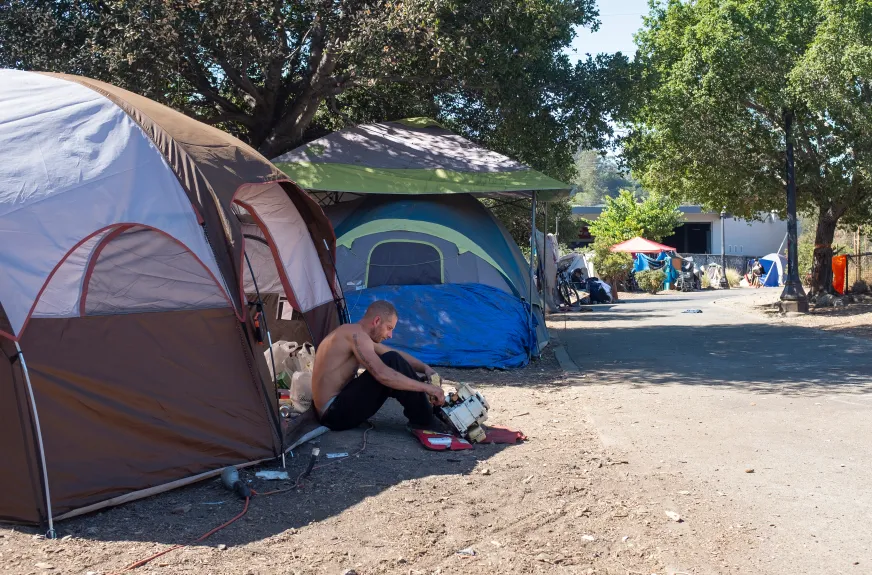
Cheyne Biskupski cleans an engine outside his tent along the Mahon Creek Path in San Rafael on Sept. 8, 2023. (Alan Dep/Marin Independent Journal)
The results from interviews with homeless people in San Rafael are both revealing and troubling.
Most of those interviewed said they want help getting off the streets, but affordable housing isn’t available and they lack access to the services they need.
San Rafael and the county have been dealing with homeless encampments cropping in parks and parking lots for several years; those challenges have been obvious, despite spending thousands of dollars to solve them.
Given the lack of affordable housing in Marin, finding a place to live in San Rafael is no easy task. But providing services – counseling and medical attention – should be much easier.
Providing counseling and medical attention are major parts of the equation to reverse the cycle of homelessness that many find themselves stuck in.
But they told interviewers in December’s survey that those services are not accessible to them.
Whether that’s the reason or an excuse, officials need to address it.
The results of the interviews are not necessarily surprising. But they do indicate that there is possible room for improvement in how counseling and services are reaching the campers.
As Councilman Eli Hill framed it, the results offer an opportunity to “better align our partnership with the county of Marin.”
Interview teams’ success, for instance, in reaching campers of the Mahon Creek encampment was impressive. They received 60 responses of the estimated 70 campers there at the time of the survey.
Working with St. Vincent de Paul Society of Marin, the Downtown Streets Team, Community Action Marin and Ritter Center was a good move and likely improved participation among the campers.
The survey’s objective was to identify barriers campers were facing and to get information to develop more effective strategies for response and programs.
If the campers, as they say, would prefer living under a roof rather than in a tent or under a tarp, that should provide impetus for the city and the county to continue their efforts to find housing.
This crisis has been a critical test for Marin’s “Housing First” strategy, which moved the homeless strategy away from overnight shelters to a focus on finding permanent housing for campers.
San Rafael’s conversion of a Kerner Boulevard office building into a 40-unit apartment complex is part of that strategy, but construction is not yet finished.
San Rafael and the county Departments of Health and Human Services deserve credit for reaching out to campers and asking them what they want and need.
Obviously, just forcing them to move from site to site has not been an effective long-term solution.
This is a slice of the city’s population that have found their last resort to live in San Rafael in a tent or under a tarp, a perilous version of “housing” in foul weather or for security.
The city’s strategy has also been complicated by the federal court’s Boise ruling, which tied municipalities’ hands, forbidding them from closing down camps without any assurance that campers had someplace to live.
In fact, the city’s efforts to eliminate the camp – which has been the source of police and fire calls – have generated legal battles and costs.
The survey creates a record of what campers say they want and need.
Those results should help move the search for solutions, those that demonstrate compassion and a commitment to public safety. Efforts over the past several years have led to frustration, but the survey should help move them in a positive direction – for campers, the city and the county.
